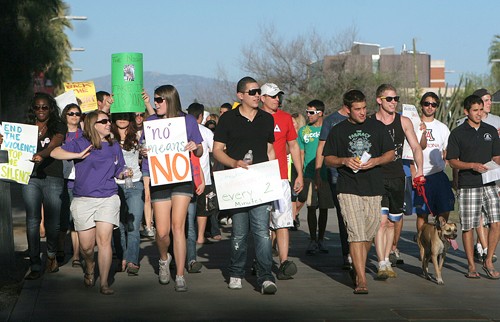More than 50 students and supporters marched to speak out and stand up against sexual violence at the annual Take Back the Night event Thursday night on the UA Mall.
The Campus Health Services OASIS program and the Women’s Resource Center have been working with students and Tucson community members since January to organize the event’s speakers, performers and supporters.
“”It was started to reclaim (women’s) safety and to take a stand against sexual violence,”” said Erin Strange, the violence prevention specialist with the OASIS program. “”It’s a really powerful message that we send to the community when we do these events.””
First held in Brussels in 1976, Take Back the Night events occur on campuses worldwide, to speak out against interpersonal and sexual violence and provide time for people to share personal stories in order to prevent these attacks from happening to anyone else.
“”Awareness is power,”” said Lori Van Buggenum, program director for the Women’s Resource Center. “”The more that we can create that awareness and educate people, the more we can create an environment that one, doesn’t tolerate violence and two, educates people about their risk.””
High school- and college-aged women are four times more likely to be victims of sexual assault than members of the general population. Women are more likely to be assaulted by someone that they know. Out of all assaults, as many as 60 percent go unreported, making the majority of sexual assaults a “”crimes of silence”” according to Van Buggenum.
Many groups on campus felt the need to drive home this sentiment.
Several speakers from the African-American Committee began the event by addressing violence, especially directed towards black women. For every black woman that reports her rape, at least 15 do not.
“”Our mission tonight is twofold: to stifle the silence and to battle sexual and interpersonal violence. We know that the problem exists, we need to enable people to speak,”” says Sheronda Jordan, a staff crisis advocate, forensic science coordinator, and supervisor on a rape examiner team. “”We can start by simply believing those that speak out.””
Many students came out to the event via previous experiences or friend recommendations.
Karen Johnston, a Health Promotion and Preventive Services student employee and former OASIS intern, got involved with the event after participating last year.
“”I think it’s great for students to really understand this topic,”” said Johnston. “”It’s something they will run into not only here (on campus) but for the rest of their life.””
Manny Duarte, of the Lambda Theta Phi multicultural fraternity, attended Take Back the Night for the first time.
“”People who see it without having had a personal experience are going to be more aware than they were before attending Taking Back the Night,”” said Duarte. “”And people who have actually been affected are of course going to have more meaning behind it.””
All over campus, the message behind the event was made clear.
“”The more people show up the better,”” said Derek Knocke, a psychology and theatre senior involved in Pride Alliance. Knocke really felt that the music and congregation in the middle of the UA mall were extremely effective in drawing attention.
“”It works because it gets people to look over here,”” said Knocke. “”It’s not just sexual abuse against straight women, but sexual abuse against any person. It can be man-on-man, woman-on-woman, woman-on-man, and vice versa. (The event) is about ending the violence, and people need to know that.””









